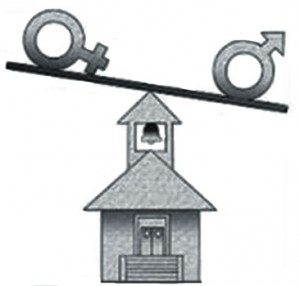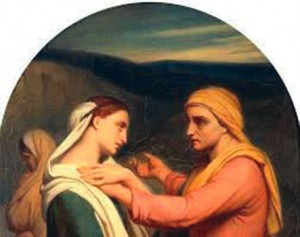Mary for Today: The Annunciation – A Call to Vocation
It is easy to imagine Mary as a young woman, soon to be married to Joseph, dreaming of a loving marriage, a family, a home in the village among the people she knew. There, she would lead a quiet life far from the gaze of the Roman occupation, protected from the bustle of the city and the thirsty desert of the south. She would live in obedience and gentleness according to the traditions of her people. When Mary’s dreams were interrupted, when that great silence took form for an instant and became comprehensible, she was afraid but receptive to the angel’s message. Her response shows that she knew God had come not to fulfil but to subvert the normal course of events. She challenged the angel: How can this come about since I am a virgin? Mary knew intuitively that the angel’s message meant a new direction in her life.
Invitation and Response:
The Church has always insisted on Mary’s freedom to choose. She was not a helpless instrument in salvation history. She was always free to say no. Christianity originates in a story of mutual loving and endeavor between a woman and God. The Annunciation was a free invitation to a woman to participate in God’s salvific action. Mary could not have known what lay before her, yet she sensed it was dangerous. The very fact that she agreed to conceive outside marriage meant that she risked death by stoning. She must have considered saying no, choosing instead to remain on the path of relative security that stretched ahead of her, marrying Joseph and enjoying the quiet of a life patterned on that of generations of wives and mothers. If she said yes, she would embark on a path that was terrifying in its unknowability, shrouded as it was in the whirlwind of God’s presence.
To step on a path of such great risk would be to break the quiet patterns of life forever, to exchange the familiar for the unknown, the predictable for the ever-new and surprising, the concrete realities of life for the Word calling her into a whirlwind. It would entail becoming a wayfarer, a person of the wilderness. There was no threat or fear of punishment in God’s invitation. If she chose the quiet life, she would be left in peace. The decision was hers and hers alone. God waited while Mary thought it over. The history of the world hung in the balance as a young girl considered the options before her. Then she said, “ I am the handmaid of the Lord, let what you have said be done to me.” And she stepped into the whirlwind.
Do Not Be Afraid:
There is awesome power in the Annunciation, but the word of God addressed to Mary is a word of healing and redemption. It is a word of calm – do not be afraid – spoken into a disordered and frightening world. But it is also a strange word, an unfamiliar voice breaking into history, and like Mary we are puzzled by its strangeness. Why do we have Matthew and Luke’s account of the conception of Jesus? Mark begins with the baptism, and John with the Prologue. What does the Virgin Birth tell us about the Kingdom of God?
We live in a world that seems governed by laws of violence and competition. Chaos pervades the relationship between men and women. Even though Genesis tells us ‘In the image of God, male and female, God created them,’ there is a struggle between the primal holistic vision of loving mutuality between the sexes and harmony in the natural world, and the oppressive and difficult realities of life. We face an apparent contradiction between belief in the created goodness of God and the unjust structures of created order that the Bible explains in terms of sin, fall, and redemption.
Redemptive Relationship:
Jesus dealt with women on a basis that completely lacked any trace of fear or hatred. Sadly this was not lived through in many of his followers who were poisoned by their contemporary culture. Patriarchy obliterated the early Christian vision of wholeness. Yet the Gospels keep alive within the heart of the Church another vision. In the Virgin Birth God realizes the promise of the beginning; speech is restored to the woman, and man is excluded from the event. Even the task of naming the child, a task sacred to the father, is given to Mary (Luke 1:31; in contrast to Matthew 1:21).
At the Annunciation Mary is not subordinate but stands as a free agent in the presence of God, without any need of a man to make her complete – or to ask permission of. But the Annunciation means more than the restoration of woman to spiritual wholeness. It also means the end of the God of patriarchy, the end of the God in whose names wars are waged and the poor are oppressed and human claims to power over one another are lent divine authority. The God of the Annunciation is a God who submits to the human will made manifest in the will of one who has no power and no authority in this world. This is a God who asks to be born of a woman. God sought the permission of a representative of the human race before coming to dwell among us – to do otherwise would have been to override human freedom. But the one appointed to speak on behalf of all people, the one who represents human freedom before God, was a young Jewish girl, who in her femaleness, her youth, and her Jewishness was as far removed from the powers of this world as it is possible to be. She was not even a Jerusalem Jew, but a Nazarene, among the lowest of the low in the social hierarchy of the day.
To insist on Mary’s virginity is to defend the co-equality of all people in the Kingdom of God. It is to defend the preferential option for the poor, which God exercised in choosing Mary. The new man is born out of the will of God and of a virgin. Only in this way can a world of loving mutuality be restored by a man who was perfect and without sin, including the Original Sin of patriarchal inheritance. The conception of Jesus is a moment of radical break when all that was good and true in the human condition was given a place in God’s earthly kingdom, including Mary’s womanliness and her Jewishness. Much of the OT depicts a patriarchal God, but there are many beautiful images of the motherly love of God: Job 38:29; Hos 11:4. God hears the cry of barren Sara and Hannah, blesses the love between Ruth and her mother-in-law, Naomi, and intervenes to save the falsely accused Susanna. The power of motherly love permeates the Bible. Mary, the Mother of God and archetype of the Church, is also the daughter of Zion. She contains within her body the reconciliation of all the rivalries and divisions of history.
By reflecting on the Annunciation we see the shape of the Kingdom of God. The Church, despite all its own failings, continues to affirm that on a quiet night in Nazareth, a Jewish girl and the God of all creation met and a new world was born. Like Mary, we may be afraid of the implications of saying yes to God’s Kingdom. To break free of old prejudices is not easy. Global structures of oppression, willful blindness to the poor, the choice of a comfortable apostolate, gender attitudes of superiority or inferiority, connivance in corrupt government, we need to remind ourselves that the Kingdom of God is not only a spiritual Kingdom – it is a political one also. It is not a Kingdom of individuals but a Kingdom of community. Like Mary, we may be deeply disturbed by the choices we are asked to make, the unknown path, and the road into newness. Sometimes we need the courage to do the unexpected.
Source: Rediscovering Mary by Tina Beattie
(Burns Oates/Dove).



 Entries(RSS)
Entries(RSS)